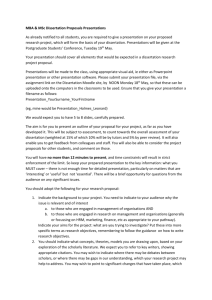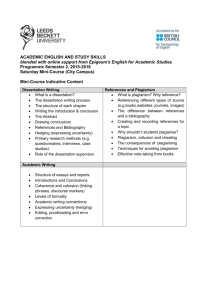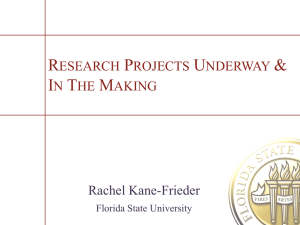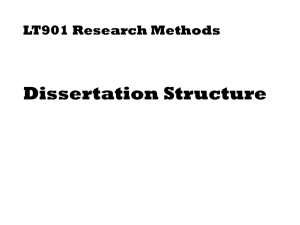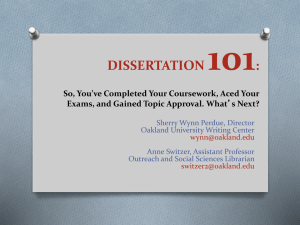Graduate Dissertation Literature Studies - Assessment Form
advertisement
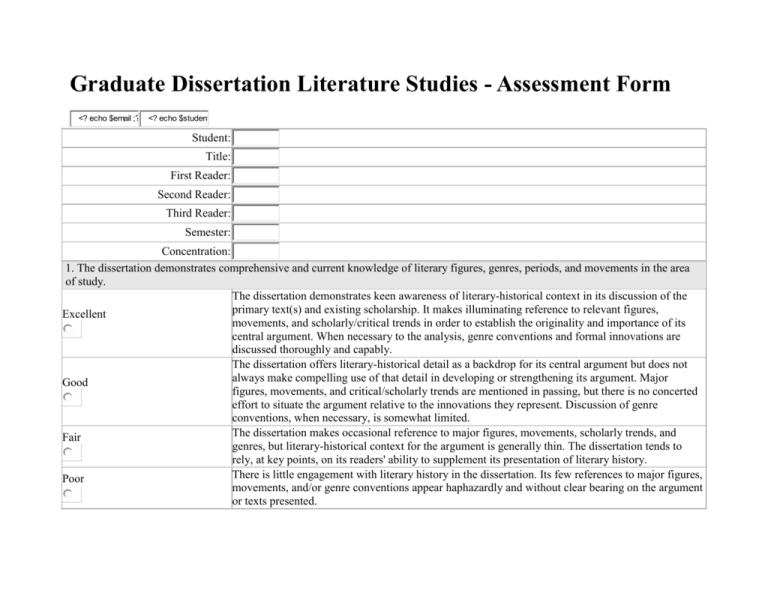
Graduate Dissertation Literature Studies - Assessment Form <? echo $email ;? <? echo $student Student: Title: First Reader: Second Reader: Third Reader: Semester: Concentration: 1. The dissertation demonstrates comprehensive and current knowledge of literary figures, genres, periods, and movements in the area of study. The dissertation demonstrates keen awareness of literary-historical context in its discussion of the primary text(s) and existing scholarship. It makes illuminating reference to relevant figures, Excellent movements, and scholarly/critical trends in order to establish the originality and importance of its central argument. When necessary to the analysis, genre conventions and formal innovations are discussed thoroughly and capably. The dissertation offers literary-historical detail as a backdrop for its central argument but does not always make compelling use of that detail in developing or strengthening its argument. Major Good figures, movements, and critical/scholarly trends are mentioned in passing, but there is no concerted effort to situate the argument relative to the innovations they represent. Discussion of genre conventions, when necessary, is somewhat limited. The dissertation makes occasional reference to major figures, movements, scholarly trends, and Fair genres, but literary-historical context for the argument is generally thin. The dissertation tends to rely, at key points, on its readers' ability to supplement its presentation of literary history. There is little engagement with literary history in the dissertation. Its few references to major figures, Poor movements, and/or genre conventions appear haphazardly and without clear bearing on the argument or texts presented. The dissertation does not demonstrate sufficient awareness of the literary-historical context to which its argument pertains. Even rudimentary signposting of the relationship between primary text(s) and major figures, movements, and genre conventions is absent. Inaccuracies and anachronisms may be present. 2. The dissertation poses a significant, valid, and original research agenda, and draws ground-breaking conclusions and implications that contribute to the given field. The dissertation represents a compellingly argued, distinctive contribution to its field. It reveals detailed engagement with secondary scholarship and identifies the limits, weaknesses, and/or Excellent unexplored implications of this scholarship. It effectively articulates the relevance and importance of its own interpretation of the primary and secondary text(s) and envisions further avenues of inquiry enabled by its findings and conclusions. The dissertation advances a significant argument shaped by awareness of secondary scholarship in its Good field. Engagement with existing scholarship sometimes lacks depth of analytical/critical insight. Interpretation of the primary text(s) is thorough, but the distinctiveness and/or importance of this interpretation relative to existing scholarship is not always as clearly established as it could be. The dissertation follows a relatively straightforward argumentative line. Engagement with existing Fair scholarship consists, for the most part, of using secondary texts to support specific points made in the interpretation of the primary text(s). The originality and importance of the argument are left largely for readers to discern. The dissertation coheres as a sustained argument, but that argument consists mainly of commenting Poor on or extending standard readings of the primary text(s). Engagement with current scholarship is sporadic and lacking in detail. The argument and conclusions drawn are of questionable originality and significance. The dissertation does not advance a coherent argument nor seek to answer a discernible research Inadequate question. It displays little awareness of secondary scholarship in its field, or else simply surveys that scholarship without critical commentary. Much of the dissertation consists of summarizing primary and secondary texts. 3. The dissertation effectively employs critical approaches/theoretical frameworks/cultural contexts appropriate to the research agenda. The dissertation represents an accomplished and well-balanced exercise in the use of Excellent critical/theoretical/cultural models to answer its research questions. It does not merely apply critical models to object texts, but also uses its primary text(s) to generate reflection on the limitations and restrictions of the interpretive models themselves. The dissertation develops its argument through Inadequate Good Fair Poor Inadequate consistent application of its critical methodology while also highlighting, when relevant, the significance of alternative readings and critical/theoretical/cultural approaches. The dissertation articulates its critical/theoretical/cultural methodology and consistently applies that model in the development of its argument. It displays little awareness of the limitations or restrictions of its own methodology and is limited in its engagement with, or ability to imagine, alternative readings, interpretations, or cultural contexts for analysis. It provides a persuasive but somewhat narrow representation of critical/theoretical/cultural approaches to literary study. The dissertation identifies key tenets of a guiding critical/theoretical/cultural model of analysis, but much of its methodology is left unstated and becomes evident to the reader only over the course of the argument itself. There are some inconsistencies in the application of the critical model to the problems addressed in the research, and little if any address to alternative interpretive possibilities. The guiding critical/theoretical/cultural assumptions of the dissertation are mostly unstated. While there is evidence that the argument has been constructed according to a set of critical principles, those principles are not evaluated for their relevance/fitness for the research question at hand. Some critical principles employed in the dissertation conflict with one another and generate inconsistencies and even contradictions over the course of the argument. The dissertation does not reveal a coherent set of guiding critical, theoretical, or cultural principles of interpretation. Its argument is disjointed and does not appear to be the product of a consistent method for pursuing the research agenda. Analysis consists of isolated observations and comments that bear little relationship to, and sometimes contradict, one another. Overall Evaluation Excellent Good Fair Comments for Student Poor Inadequate Comments for Department

